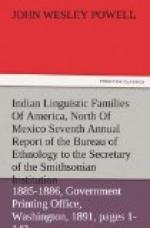GEOGRAPHIC DISTRIBUTION.
It is impossible to assign definite limits to the area occupied by the tribes of this family. From documentary testimony of the sixteenth and seventeenth centuries the limits of the family domain appear to have been about as follows: In general terms the present northern limits of the State of Florida may be taken as the northern frontier, although upon the Atlantic side Timuquanan territory may have extended into Georgia. Upon the northwest the boundary line was formed in De Soto’s time by the Ocilla River. Lake Okeechobee on the south, or as it was then called Lake Sarrape or Mayaimi, may be taken as the boundary between the Timuquanan tribes proper and the Calusa province upon the Gulf coast and the Tegesta province upon the Atlantic side. Nothing whatever of the languages spoken in these two latter provinces is available for comparison. A number of the local names of these provinces given by Fontanedo (1559) have terminations similar to many of the Timuquanan local names. This slender evidence is all that we have from which to infer the Timuquanan relationship of the southern end of the peninsula.
PRINCIPAL TRIBES.
The following settlements appear upon the oldest map of the regions we possess, that of De Bry (Narratio; Frankf. a. M. 15, 1590):
(A) Shores of St. John’s River, from mouth to sources:
Patica. Utina.
Saturiwa. Patchica.
Atore. Chilili.
Homolua or Molua. Calanay.
Alimacani. Onochaquara.
Casti. Mayarca.
Malica. Mathiaca.
Melona. Maiera.
Timoga or Timucua. Mocoso.
Enecaqua. Cadica.
Choya. Eloquale.
Edelano (island). Aquonena.
Astina.
(B) On a (fictitious) western tributary of St. John’s
River, from mouth
to source:
Hicaranaou.
Appalou.
Oustaca.
Onathcaqua.
Potanou.
Ehiamana.
Anouala.
(C) East Floridian coast, from south to north:
Mocossou.
Oathcaqua.
Sorrochos.
Hanocoroucouay.
Marracou.
(D) On coast north of St. John’s River:
Hiouacara.
(E) The following are gathered from all other authorities, mostly from the accounts of De Soto’s expedition:
Acquera. San Mateo (1688). Aguile. Santa Lucia de Acuera Basisa or Vacissa (SE. coast). (1688). Tacatacuru. Cholupaha. Tocaste. Hapaluya. Tolemato. Hirrihiqua. Topoqui. Itafi Tucururu (perhaps a province). (SE. coast) Itara Ucita. Machaua (1688). Urriparacuxi. Napetuca. Yupaha Osile (Oxille). (perhaps a province). San Juan de Guacara (1688).




